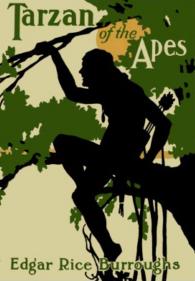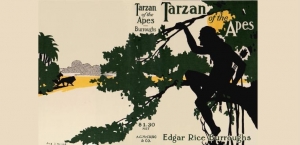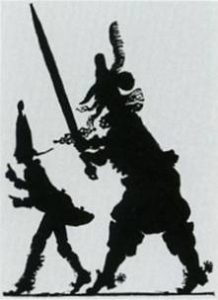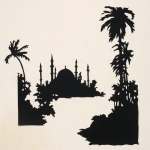In the wake of the successful serial publication of Edgar Rice Burroughs first published stories, the Chicago publishing house A. C. McClurg and Company produced Burroughs’ first Tarzan story, Tarzan of the Apes. The dust jacket for this seminal Tarzan book was illustrated by Fred J. Arting, about whom we know almost nothing, except that he worked as an illustrator in Chicago between 1910 and 1917 producing illustrations for McClurg and for Reilly & Britton who in 1918 became Reilly & Lee publishers.*
What intrigued me about Arting’s cover design for this first Tarzan book was his use of a painted silhouette for the figure of Tarzan seated on the branch of a large tree overlooking the plain where the silhouette form of a lion strolls. At Tarzan’s side rests a quiver that holds arrows with fluffy feather-fletchings. Depicted in silhouette as a feathery mass, they seem to be the character’s only other decorative element besides the pendant hanging from around his neck. I am assuming that Arting chose to use the painted silhouette technique as a way to depict a man wearing only a minimal loin covering without visually giving too much away.
Since the 18th-century some silhouette cutters created full scenes cut from cards. These pictures are known as ‘paper cuts.’ Painted silhouettes were also popular in England in the 18th and 19th-centuries. Used primarily for portraits (also known as shades, profile miniatures, and shadow portraits because they were made by tracing the shadow-cast outline of a back-lit portrait figure against a foreground shade) they were an inexpensive alternative to painted portrait miniatures and best of all they were also inexpensively copied once the initial outline was drawn. After the edge was drawn, the artist detailed the figure’s hair and clothing around the edges of the form using finer brushes and pigment. An artist’s skill was revealed in the delineation of feathers and frills, so to speak.
In the late 19th in America, century, Howard Pyle created a number of story illustrations that while they look like silhouette cut scenes are in fact made from painted silhouette forms.** You can see in his illustration, Fritz Guides the Baron, for a story he wrote that was published in St. Nicholas magazine in the fall of 1877, that Pyle used this technique to emphasize the finicky decorative details of the Baron’s outfit: notice the spurs on his heels, the ruffle of his collar, his long hair, beard, and mustache and especially feathery vane that floats off the feather’s central shaft called the rachis (the quill is the part of the shaft that extends under the bird’s skin).
Howard Pyle (1853-1911; )Fritz Guides the Baron, 1877; Illustration for “Drummer Fritz and His Exploits” by Howard Pyle in St. Nicholas v. IV, no. 718 (September 1877)
Not long after Howard Pyle’s beguiling stories and painted silhouettes were created for St. Nicholas magazine, the American illustrator and silhouette artist John Bennett also created stories and their silhouette images for St. Nicholas under the pseudonym Master Skylark. Bennett began cutting silhouettes as a child during the time he experience fragile health.
John Bennett (1865-1956); The Minarets of the City c.1928; Silhouette illustration for The Persian Columbus; Cut paper glued to board; Delaware Art Museum, Acquisition Fund, 2008, 2009-1.11
Silhouettes hold a special place in the history of illustration, whether they were cut or painted. Obviously they can visually relate an elaborately constructed story line or a rich visual narrative. But what they do best is to clearly detail the wonderfully elaborate lines and curves that make up the edges of things. Without depending on visual clues to indicate emotion or state of mind, we can instead enjoy the details of form and edge to see more than meets the eye. We may not be familiar with all the illustrators who employed silhouette images to tell their stories, so to the list we need to add Hans Christian Andersen, who would often cut scenes of his stories as he told them; Charles Dana Gibson who’s youthful skill as a paper cutter had the sculptor Augustus Saint-Gaudens suggesting that Gibson train to be an illustrator; and Arthur Rackham who illustrated silhouette versions of Cinderella in 1919 and The Sleeping Beauty in 1920 both for the editor Charles Seddon Evans and in 1932 some more silhouettes for Hans Christian Andersen’s Fairy Tales.
* Reilly & Britton and its successor firm were best known as the publishers of L. Frank Baum’s Oz series of books from Baum’s second volume through four decades of publications.
** The Delaware Art Museum created a special retrospective exhibition, Howard Pyle: American Master Rediscovered which closed there on March 4, 2012. After its Wilmington, DE debut this exhibit will open at the Norman Rockwell Museum in Stockbridge, MA on June 9, 2012 and will be available through October 28, 2012.
March 22, 2012
By Joyce K. Schiller, Curator, Rockwel Center for American Visual Studies, at the Norman Rockwell Museum










